LP.8.1 COVID variant is on the rise: Symptoms and Treatment (2025)
More than five years since COVID was declared a pandemic, we’re still facing the regular emergence of new variants of the virus, SARS-CoV-2.
The latest variant on the rise is LP.8.1. It’s increasing in Australia, making up close to one in five COVID cases in New South Wales.
Elsewhere it’s become even more dominant, comprising at least three in five cases in the United Kingdom, for example.
So what is LP.8.1? And is it cause for concern? Let’s look at what we know so far.An offshoot of Omicron
LP.8.1 was first detected in July 2024. It’s a descendant of Omicron, specifically of KP.1.1.3, which is descended from JN.1, a subvariant that caused large waves of COVID infections around the world in late 2023 and early 2024.
The World Health Organization (WHO) designated LP.8.1 as a variant under monitoring in January. This was in response to its significant growth globally, and reflects that it has genetic changes which may allow the virus to spread more easily and pose a greater risk to human health.
Specifically, LP.8.1 has mutations at six locations in its spike protein, the protein which allows SARS-CoV-2 to attach to our cells. One of these mutations, V445R, is thought to allow this variant to spread more easily relative to other circulating variants. V445R has been shown to increase binding to human lung cells in laboratory studies.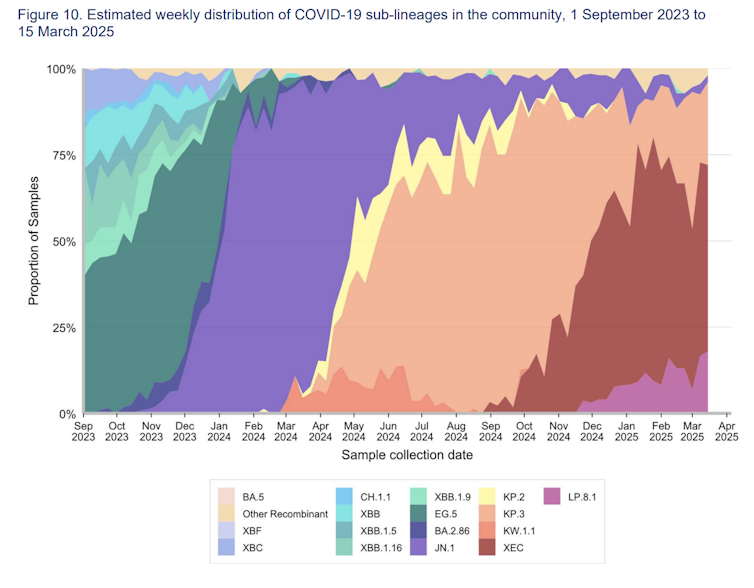
Notably, the symptoms of LP.8.1 don’t appear to be any more severe than other circulating strains. And the WHO has evaluated the additional public health risk LP.8.1 poses at a global level to be low. What’s more, LP.8.1 remains a variant under monitoring, rather than a variant of interest or a variant of concern.
In other words, these changes to the virus with LP.8.1 are small, and not likely to make a big difference to the trajectory of the pandemic.
That doesn’t mean cases won’t rise
COVID as a whole is still a major national and international health concern. So far this year there have been close to 45,000 new cases recorded in Australia, while around 260 people are currently in hospital with the virus.
Because many people are no longer testing or reporting their infections, the real number of cases is probably far higher.
In Australia, LP.8.1 has become the third most dominant strain in NSW (behind XEC and KP.3).
It has been growing over the past couple of months and this trend looks set to continue.
This is not to say it’s not growing similarly in other states and territories, however NSW Health publishes weekly respiratory surveillance with a breakdown of different COVID variants in the state.
Sequences of LP.8.1 in the GISAID database, used to track the prevalence of variants around the world, increased from around 3% at the end of 2024 to 38% of global sequences as of mid March.
In some countries it’s climbed particularly high. In the United States LP.8.1 is responsible for 55% of cases. In the UK, where LP.8.1 is making up at least 60% of cases, scientists fear it may be driving a new wave.
Will COVID vaccines work against LP.8.1?
Current COVID vaccines, including the most recently available JN.1 shots, are still expected to offer good protection against symptomatic and severe disease with LP.8.1.
Nonetheless, due to its designation as a variant under monitoring, WHO member countries will continue to study the behaviour of the LP.8.1 variant, including any potential capacity to evade our immunity.
While there’s no cause for panic due to LP.8.1 variant at this stage, COVID can still be a severe disease for some. Continued vigilance and vaccination, particularly for medically vulnerable groups, is essential in minimising the impact of the disease.About the Author: Thomas Jeffries is Senior Lecturer in Microbiology, Western Sydney University.
Source: First published on The Conversation.
Treatment
If you have difficulty breathing or shortness of breath (dyspnea), chest pain or chest pressure, or lost motor skills or the ability to speak, seek medical attention immediately.
In terms of a treatment strategy, we want to start with killing the virus in the upper respiratory system. Nasal rinses and nose or throat sprays are effective for this. We have advice on this in the I-CARE: Early COVID treatment protocol. This should be paired with systemic antivirals like ivermectin and hydroxychloroquine.
Next, it is important to take a range of supplements that help boost the immune system. This includes things like: Vitamin D, Vitamin C, Quercetin with bromelain, N-acetyl cysteine, Probiotics, Omega-3 fatty acids, Melatonin (slow release is best), Zinc (taken with Quercetin), Selenium, and Andrographis.
If you are symptomatic, try a low-histamine diet that cuts out foods like sauerkraut and other fermented foods, alcohol, processed meat, aged cheese, certain types of fish and shellfish, and nightshade vegetables like tomato and eggplant.
If you’ve been following FLCCC for a while, much of this will sound familiar. Our early treatment protocol is still the right place to start when COVID comes to call.
Prevent illness in the first place
While we’re at it, let’s talk about getting your immune system into shape, and other evasive actions you can take to make sure you’re strong, healthy, and ready to fight off any virus coming your way this fall.
- Follow our prevention protocol: Some easy things you can do include mouthwash and nasal spray, zinc supplements, Vitamins C and D, melatonin, quercetin or resveratrol, and elderberry.
- Clean up your diet: It almost goes without saying, but what you eat and when you eat it has a profound effect on your overall health. Intermittent fasting and balancing your gut microbiome are key.
- Get enough Vitamin D: There is a clear link between low vitamin D levels and the risk of infections and other illnesses. Fortunately, boosting your vitamin D with supplementation is fairly easy and inexpensive.
- Reduce stress: Too much stress can create hormonal and other imbalances that suppress your immune system. Incorporate stress-reduction techniques into your daily routine for your overall well-being and to ensure you’re prepared to fight off infection.
- Get good sleep: Sleep recharges your body so your systems can function properly. On average, adults need between seven and nine hours of sleep each night.
- Get outside and get some fresh air: Spending about 30 minutes outdoors each day can help the skin synthesize vitamin D, and sunlight has many other great therapeutic powers too.
Many people have asked whether they should start up a prophylactic treatment of ivermectin again. On that front, our advice has not really changed: if you have significant comorbidities, lack natural immunity, or have a suppressed immune system you may want to try a twice-weekly dose of ivermectin at 0.2 mg/kg. Likewise, consider it if you are currently suffering from long COVID or post-vaccine syndrome and are not currently being treated with ivermectin. If you have an upcoming situation where you may have high possible exposure — such as travel, weddings, or conferences — taking daily ivermectin starting two days before departure and either daily or every other day during the period of high exposure is a reasonable approach.
Remember to immediately initiate daily ivermectin at treatment doses (0.4 mg/kg) at the first signs of any kind of viral syndrome. It bears repeating: Early treatment is essential!
The information in this article is a recommended approach to preventing and treating COVID-19 infections in adults. Patients should always consult with a trusted healthcare provider before starting any medical treatment.
Source: https://imahealth.org/covid-is-on-the-rise-again-heres-why-you-shouldnt-panic/
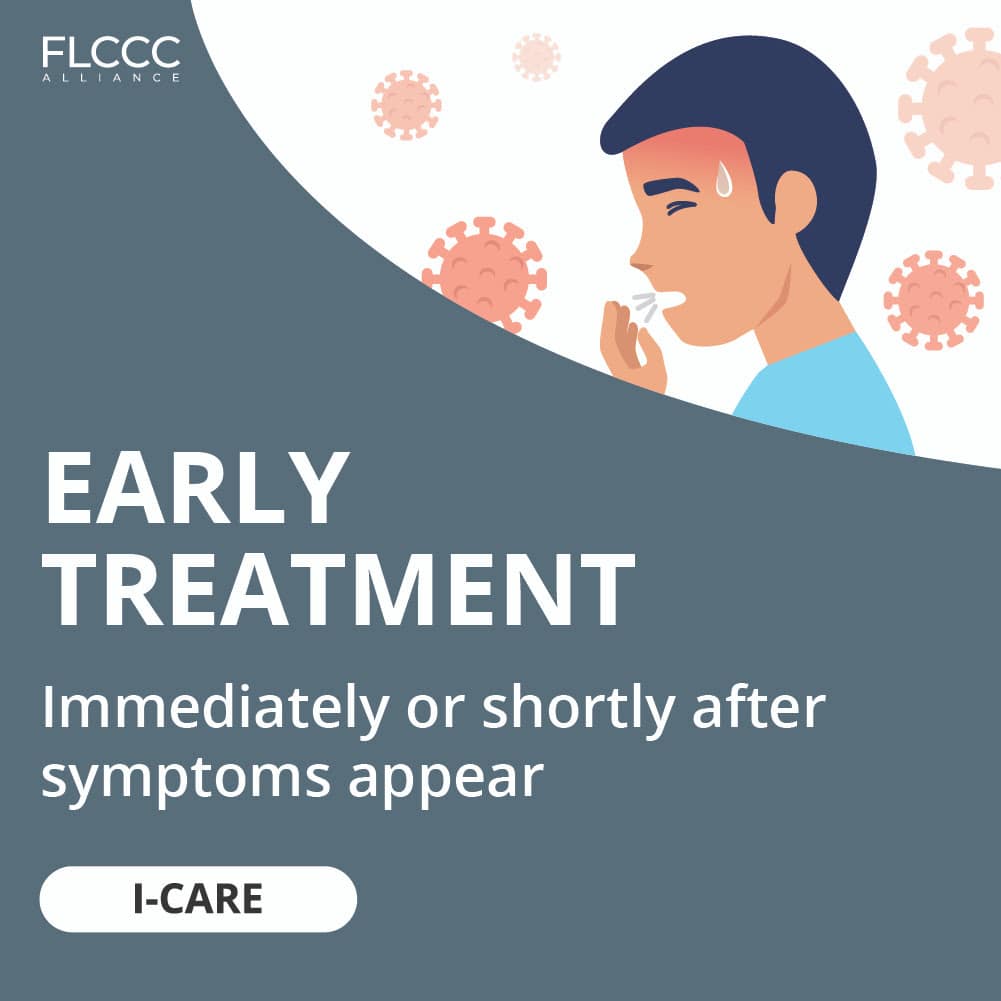
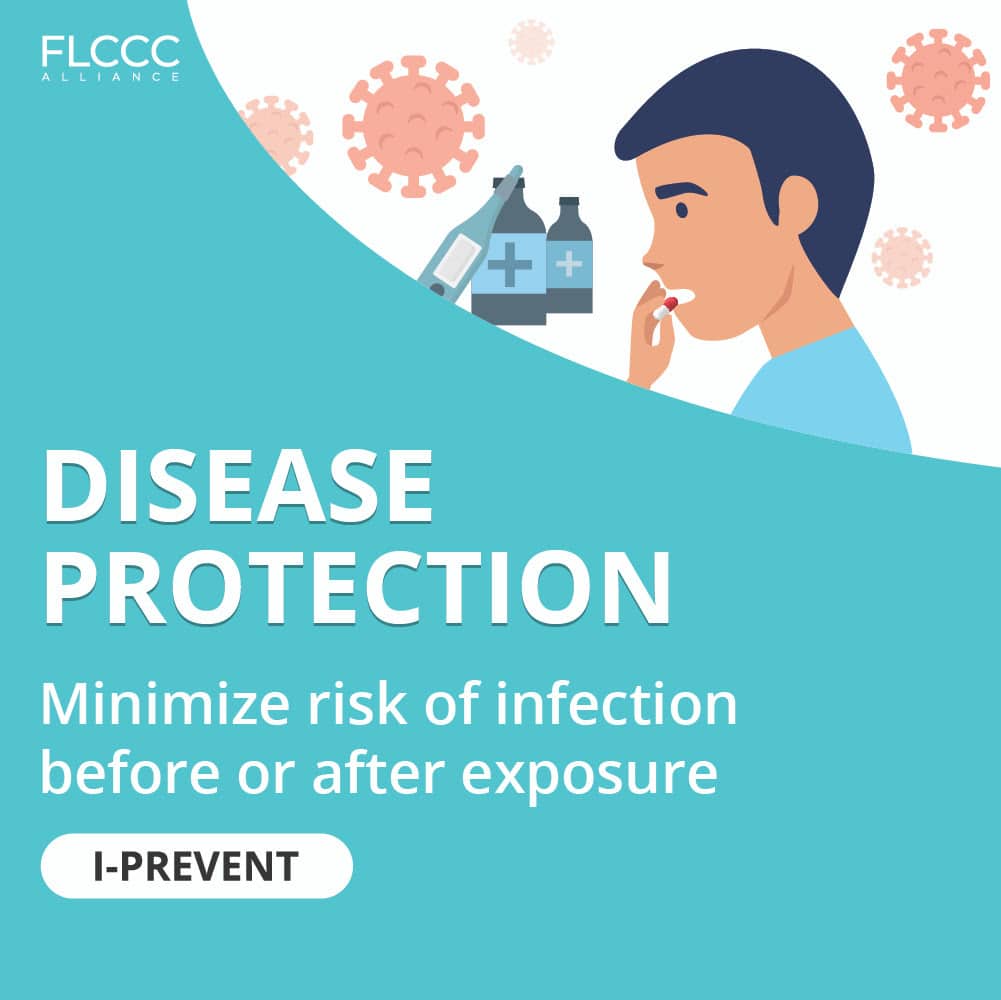




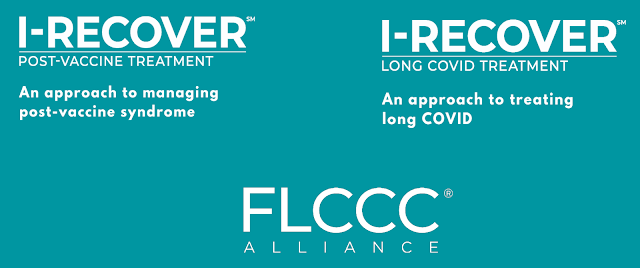
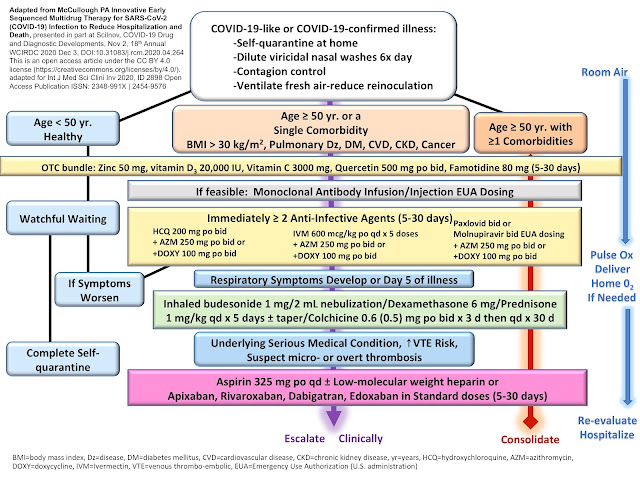
.png)

Comments
Post a Comment